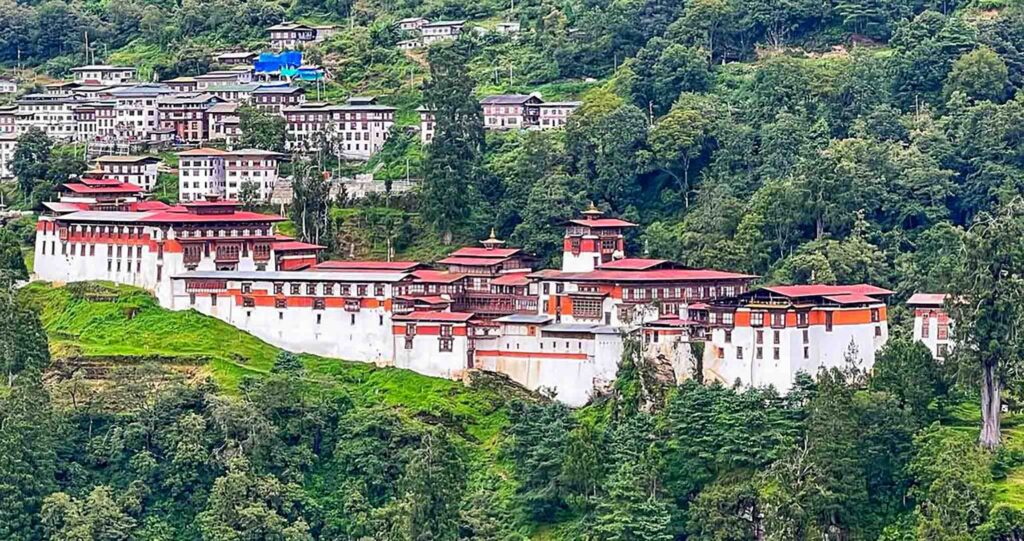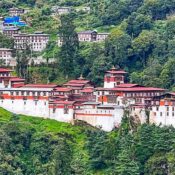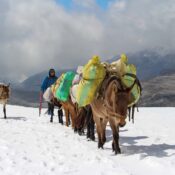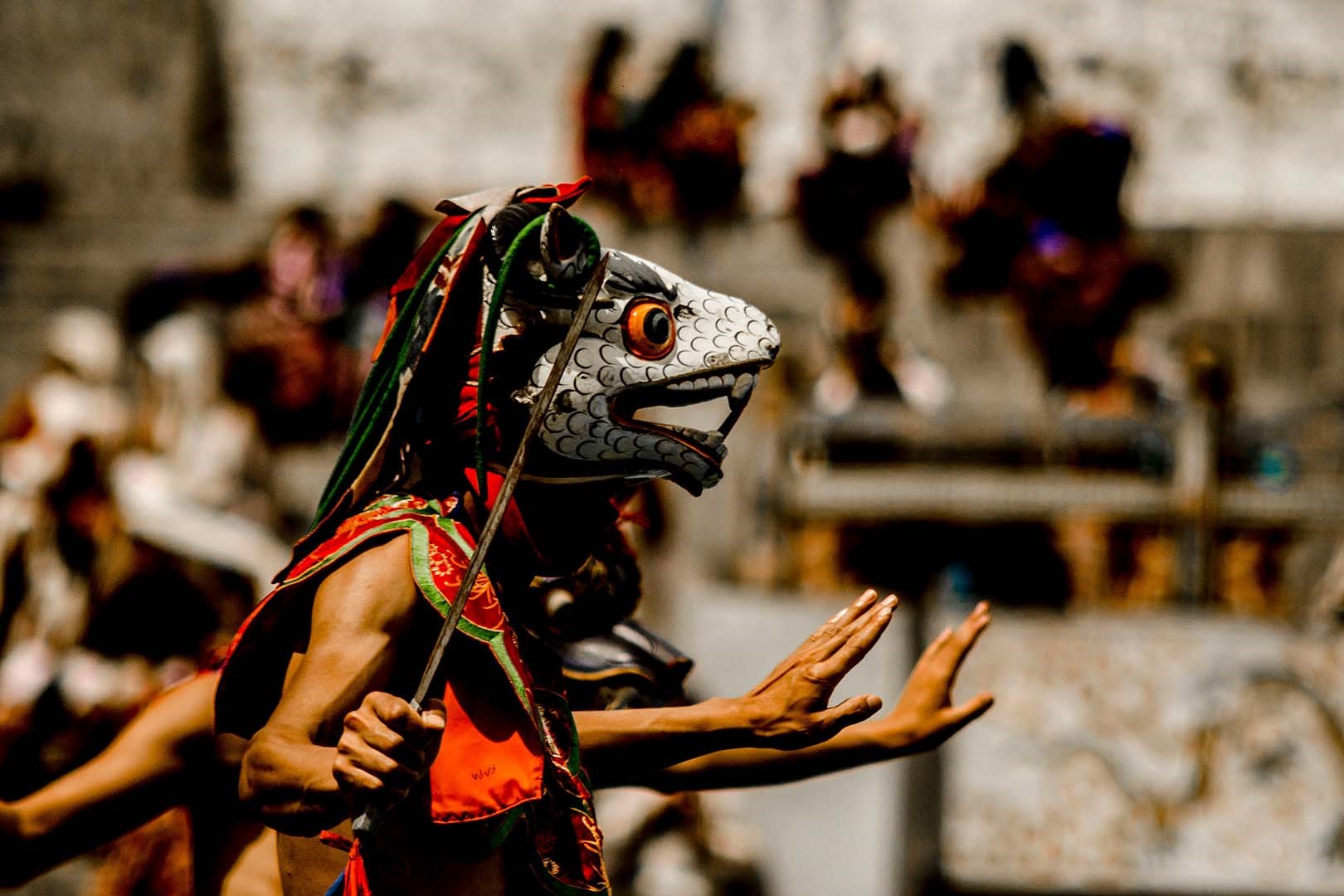Tashigang Dzong

Tashigang Dzong
Tashigang Dzong. The landscape on which the Dzong stands is not only striking but also arouses curiosity. The Dzong stands majestically on a hillock. Situated on the ledge of a mountain with cliffs on three sides, Trashigang Dzong overlooks the Dan-gmechhu, which flows at its base. It is accessible only from the north. Due to its location, Trashigang Dzong is one of the most strategically placed Dzongs in Bhutan. Trashigang Dong was founded according to the prophecies of Zhabdrung Ngawang Namgyal. To spread the Drukpa rule over Sharchog Khorlo Tisb Gyed (the eight regions of eastern Bhutan), he directed the Trongsa Penlop, Chhogyal Minjur Tempa, to subdue the local chieftains and . build a Dzong at the present site. Soon after, trouble started in the east.
The chieftain of Kurote Tangmachu was killed by his rivals, Pelchen Dharma and Phagidung. The widow of the king appealed to the Trongsa Penlop for protection. The Penlop’s forces moved eastward, overpowering one chieftain after another. First, they defeated Chokhar Deb in Bumthang, then Lhuntse was captured and a Dzong was built. Moving farther east, they captured Trashi Yangtse and brought Zhongar under their control. Penlop Chhogyal Minjur Tempa returned to Trongsa, leaving his lieutenants Lam Namsey and Umze Damchoe Rabgay to complete the work in Trashigang.

The Trashi-gang chieftains Tshewang and Langa, having heard of the exploits of the Trongsa forces, submitted without a fight and relinquished their domains. Tshewang and Langa were compensated with chieftainships in Samkhar and Rangshikhar, where they established the lineage of Samkhar Khoche and Rangshikhar Khoche. At the time, almost every village in Trashigang was headed by petty chieftains. The places from where they reigned were known as khar, literally meaning a wall of stones, which could be equated to castles or Dzongs. Villages like Bikhar, Samkhar, Tshangkhar, Rangshikhar, Domkhar and Jamkhar were seats of power; and even today the names are retained. The first Dzong in.
Trashigang was built in Jamkhar village in the 9th century CE, when Lhasey Tsangma, the elder brother of Thri Relpachen, who had been banished from Tibet, settled in Jamkhar, where the local people erected a Khar. He later built the Tshenkharla Dzong above Duksom, where it remains a stille seen today easily in other places. A chieftain named Lam Nagseng, from Merak-Sakten, refused to surrender to the Trongsa Penlop’s forces. He was eventually defeated, however, and fled to Tibet. Once the rebellions were curbed, a new Dzong was constructed at Bjirizor in Khaling. In a later conflict, Lam Nagseng was again at the forefront of the rebellion, but again he was defeated by the Trongsa Penlop’s troops. Chhogyal Minjur Tempa ordered. Kudung Pekar Chophel to build the Dzong at Bengkhar due to its strategic location. In 1659 the Dzong was constructed and named Trashigang Dzong, Fortress of the auspicious mound.
Tashigang Dzong Consecration and Invasion
The Dzong includes a Gonkhang (inner sanctum of a guardian deity) and several other temples: the Lam Lhakhang is dedicated to the Eight Great Indian Masters of Buddhism; the Guru Lhakhang has a statue of Guru; the Tshogshing Lhakhang, where the lineages of the Drukpa, Karmapa, Nyingmapa, and Dzongchen Lamas are represented; and the assembly hall of the monks. In the central tower is the Goenkhang, dedicated to Mahakala and containing statues of Goenpo Chamdrel Sum (Mahakala, Mahakali and the Raven Crown), and Goenpo Lhengyed. Its wall paintings were done by Lam Sonam Zangpo, Lam Moenlam Rabzang, and Kholong Kota. The Tshechu Lhakhang has images of Guru Rinpoche and his eight manifestations.
Tibetan invasions and the myth behind the “Sky Dzong”
After its construction, Trashigang Dzong withstood various invasions by Tibetan troops. Interesting local lore states that when the Tibetan troops descended from Muktangkhar, a village on the other side of the Dzong, they saw the Dzong below and said, “Trashigang Dzong is not a sky Dzong but a ground Dzong”; however, on reaching the banks of Dang-mechhu they looked up and, seeing the impenetrable Dzong aloft, they agreed that it was a “sky Dzong” after all, and they fled.
Ever since the Dzong was built, the guardian deity of the Dzong, Garab Wangchuk, said to have been brought from Wamrong, is believed to have protected the Dzong from both internal and external dangers.
Renovation
During the time of the fourth Deb, Tenzin Rabgye, the entire Trashigang Dzong was enlarged and a Gonkhang was added.
In 1710, the second Dzongpon Khamsum Wangdi commissioned the writing of the Kanjur (translation of the words of Buddha). In 1958 the present Dzong was enlarged by Dzong-pon Thinley Tobgyal, popularly known as Dasho Dophagla.
Renowned carpenters such as Tharchen from Tomiyangtse, Rangparpa Karma Lhuendup, and Zotag from Kurtoe were summoned for the works.
The Trashigang Dzong was blessed with solemn sanctity because a splendid ceremony was performed by His Holiness Dudjom Rinpoche, along with Lama Moenlam Rabzang, Lama Sonam Zangpo, Lama Khalong Kota and Lama Neten of Trashigang Rabdey
Tshechhu and Thongdrel
Tshechu in Trashigang Dzong is conducted annually from the 7th to the 11th day of the tenth month of the Bhutanese calendar. The seventh day is the day of bathing for monks. On the eighth, the rehearsals take place; and on the ninth, the real festival begins. The tenth day is the day of the unfolding and display of Neten Chudrug (Sixteen Arhats) Thongdrol (large scroll) along with different dances. On the final day, the old Thongdrol of Guru Tshengyed (8 manifestations of Guru Rinpoche) is displayed with the Guru Tsh-engyed dance.
The Neten Chudrug Thongdrel spread over the utse was built in 2001, aided by contributions made by the Rabdey, Dzongkhag officials, and the business community.
The Thongdrel has a fifty-nine-foot-tall Buddha in the centre, surrounded by the sixteen Arhats rising thirteen feet each. It has a fifteen-foot-tall image of Guru Rinpoche and Zhabdrung Ngawang Namgyal and a nine-foot-tall portrait of Tshelha Namsum (Buddha of long life), Dolkar (White Tara), and Namgyal (Bizaya).
Trashigang Rabdey has 210 monks.
Visitors Information
Visitors are allowed to enter the Dzong.




